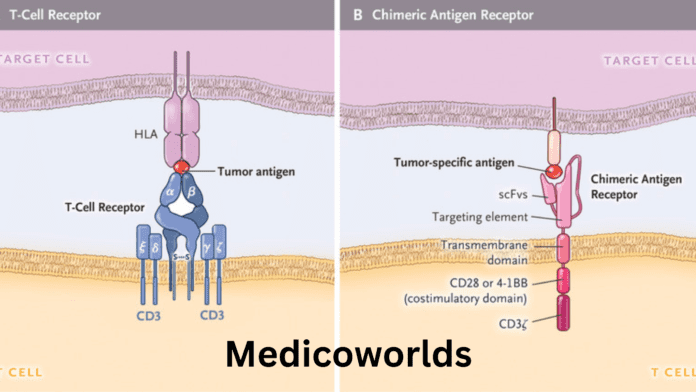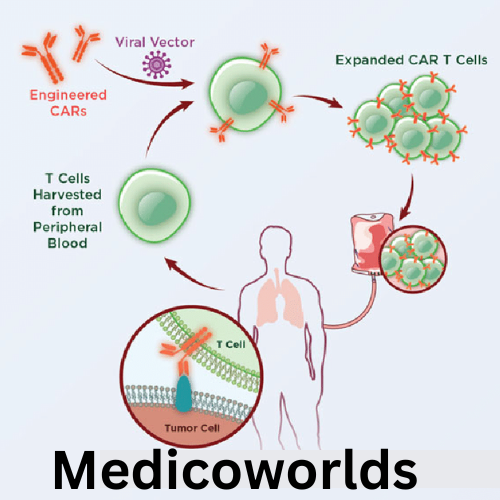In the ever-evolving landscape of cancer treatment, Chimeric Antigen Receptor (CAR) therapy has emerged as a cutting-edge approach, offering new hope in the fight against certain types of cancer. This section provides a comprehensive overview of CAR therapy, exploring its significance in the broader context of immunotherapy and personalized cancer care.
Advancements in Immunotherapy
- Shift towards immunotherapy in cancer treatment
- CAR therapy as a pioneering immunotherapeutic technique
- Harnessing the body’s natural defense mechanisms for targeted cancer eradication
Personalized Approach to Cancer Care
- Customization of treatment based on individual patient profiles
- CAR therapy’s role in tailoring the immune response to specific cancer types
- Potential for improved treatment outcomes with a personalized approach
Understanding CAR Therapy
In this section, we delve into the fundamental principles behind CAR therapy, shedding light on its core concepts and the innovative mechanisms that make it a unique and promising avenue in cancer treatment.
Definition and Concept of CAR Therapy
- Unpacking the concept of Chimeric Antigen Receptor therapy
- Redirecting the immune system to recognize and attack cancer cells
- Overview of the synthetic receptors engineered for enhanced targeting
Targeting Cancer Cells with Precision
- Achieving specificity in identifying cancer cells
- Minimizing collateral damage to healthy cells
- Enhanced precision as a key advantage of CAR therapy
Mechanism of Action
Understanding the mechanism of CAR therapy is pivotal to appreciating its efficacy. This section dissects the role of Chimeric Antigen Receptors and the intricate process by which they activate the immune system against cancer.
Synthetic Receptors in Cancer Recognition
- Design and construction of Chimeric Antigen Receptors
- Recognition of specific antigens on the surface of cancer cells
- Triggering an immune response against identified cancerous cells
Activation of Immune Response Against Cancer
- Signaling pathways activated by CARs
- Amplification of immune response for targeted cancer cell destruction
- Mobilization of the body’s defense mechanisms in the battle against cancer
Development and Milestones
Tracing the historical trajectory of CAR therapy is essential to appreciate the significant milestones that have shaped its evolution into a groundbreaking cancer treatment.
Pioneering Research and Breakthroughs
- Key milestones in the development of CAR therapy
- Initial challenges and breakthroughs that paved the way for clinical applications
- Evolution from theoretical concepts to practical, life-changing treatments
Evolution of CAR Therapy Over the Years
- Notable improvements and refinements in CAR therapy techniques
- Continuous learning from clinical trials and patient outcomes
- Future directions in research and development
Components of CAR Therapy
A closer look at the fundamental components of CAR therapy provides insights into the meticulous process of identifying target antigens and constructing effective Chimeric Antigen Receptors.
Selection Criteria for Effective Targeting
- Criteria for identifying suitable antigens for targeting
- Balancing specificity and prevalence in the selection process
- Ensuring effective recognition and response against cancer cells
Importance of Specific Antigen Recognition
- Significance of accurate antigen identification in preventing off-target effects
- Minimizing the risk of autoimmune responses through careful antigen selection
- Precision as a cornerstone for the success of CAR therapy
Construction of Chimeric Receptors
Genetic engineering is a critical aspect of CAR therapy. This section explores the intricate process of designing and constructing Chimeric Antigen Receptors for optimal performance.
Designing Receptors for Enhanced Efficacy
- Genetic modifications to improve receptor binding affinity
- Incorporating safety features in the receptor design
- Iterative improvements to enhance therapeutic outcomes
Ensuring Safety and Precision in Construction
- Protocols to minimize off-target effects during receptor construction
- Quality control measures to guarantee the safety and functionality of CARs
- Striking a balance between robustness and precision in design
Cell Types Utilized
Understanding the role of T cells in CAR therapy is crucial. This section elucidates the importance of T cells in orchestrating a targeted and effective immune response against cancer.
Importance of T Cells in Immune Response
- Overview of T cells as key players in the immune system
- Role of T cells in recognizing and attacking abnormal cells, including cancer
- Harnessing the natural capabilities of T cells in CAR therapy
Modification of T Cells for Targeted Action
- Genetic modifications to enhance T cells’ cancer-targeting abilities
- Introduction of Chimeric Antigen Receptors to redirect T cells
- Empowering T cells with precision targeting for improved cancer cell elimination
CAR Therapy Process
The journey of CAR therapy unfolds in a series of meticulous steps, from the isolation of patient T cells to the infusion of genetically modified cells. This section provides a step-by-step exploration of the CAR therapy process.
Collection and Preparation for Genetic Modification
- Isolation of T cells from the patient’s bloodstream
- Preparing T cells for genetic modification in the laboratory
- Ensuring the viability and health of isolated T cells
Laboratory Procedures for CAR Integration
- Genetic modification techniques employed in the laboratory
- Integrating Chimeric Antigen Receptors into isolated T cells
- Validation and testing to confirm successful modification
Genetic Modification
The heart of CAR therapy lies in the genetic modification of T cells to equip them with Chimeric Antigen Receptors. This section delves into the techniques and considerations involved in this critical process.
Insertion of Chimeric Antigen Receptors
- Genetic engineering methods to insert CARs into T cells
- Ensuring stable integration of synthetic receptors
- Optimization of insertion techniques for enhanced therapeutic outcomes
Ensuring Stability and Functionality of Modified Cells
- Quality control measures to verify stability and functionality
- Testing modified T cells for intended responses against cancer cells
- Iterative improvements to enhance the overall efficacy of modified cells
Infusion of Modified Cells
Once genetically modified, T cells are reintroduced into the patient’s body. This section explores the process of infusing modified cells and the subsequent targeting of cancer cells with precision.
Monitoring the Distribution in the Bloodstream
- Tracking the movement of modified T cells in the patient’s bloodstream
- Understanding the kinetics of cell distribution after infusion
- Assessing the initial response and circulation of modified cells
Targeting Cancer Cells with Precision
- Mechanisms by which modified T cells recognize and target cancer cells
- Specificity in targeting cancer antigens while sparing healthy cells
- Amplifying the immune response at the site of cancer for optimal efficacy
Efficacy and Clinical Outcomes
The proof of CAR therapy’s success lies in the clinical outcomes observed in patients. This section examines the results of clinical trials, success stories, and patient testimonials.
Success Stories and Patient Testimonials
- Real-life accounts of patients who have undergone CAR therapy
- Positive outcomes and long-term success stories
- The emotional impact of CAR therapy on patients and their families
Monitoring Long-Term Effects and Recurrence Rates
- Post-treatment surveillance for potential long-term effects
- Strategies for monitoring and managing any recurrence of cancer
- Long-term considerations for patients who have undergone CAR therapy
Challenges in CAR Therapy
While Chimeric Antigen Receptor therapy holds immense promise, it is not without challenges. This section addresses potential side effects, variability in patient responses, and the ongoing efforts to overcome these hurdles.
Balancing Effectiveness and Safety
- Navigating the delicate balance between therapeutic effectiveness and safety
- Strategies to minimize side effects while optimizing anti-cancer responses
- Iterative improvements to enhance the overall safety profile of CAR therapy
Addressing Variability in Patient Responses
- Recognizing and understanding the diverse responses to CAR therapy
- Tailoring treatment approaches based on individual patient characteristics
- Ongoing research to identify factors influencing treatment variability
Ongoing Research and Innovations
The field of CAR therapy is dynamic, with ongoing research and innovations driving continuous improvements. This section explores the latest advancements and future possibilities in CAR therapy.
Exploration of New Target Antigens
- Identifying novel antigens for more comprehensive cancer targeting
- Expanding the range of cancers that can be effectively treated with Chimeric Antigen Receptor therapy
- Innovations in antigen discovery and validation for enhanced therapeutic options
Improvements in Genetic Modification Techniques
- Advances in genetic engineering methods for more efficient CAR integration
- Fine-tuning genetic modification to enhance receptor stability and functionality
- Iterative refinements in laboratory procedures for optimal therapeutic outcomes
Cost and Accessibility
While CAR therapy shows great promise, concerns about its cost and accessibility persist. This section examines the current landscape and ongoing initiatives to make CAR therapy more widely available and affordable.
Initiatives to Make CAR Therapy More Widely Available
- Collaborative efforts to increase accessibility to Chimeric Antigen Receptor therapy
- Advocacy for insurance coverage and reimbursement for patients
- Strategies to reduce financial barriers for a broader patient population
Insurance Coverage and Financial Considerations
- Overview of current insurance coverage for CAR therapy
- Advocacy for expanded coverage and reimbursement policies
- Financial considerations for patients considering CAR therapy as a treatment option
Comparative Analysis with Traditional Treatments
Comparing CAR therapy with traditional treatments, such as chemotherapy and radiation, provides a nuanced understanding of its advantages and disadvantages.
Advantages of CAR Therapy
- Targeted approach to cancer treatment
- Reduced damage to healthy cells compared to traditional treatments
- Potential for long-term effectiveness and durable responses
Disadvantages of CAR Therapy
- Specific challenges and limitations of Chimeric Antigen Receptor therapy
- Contrasting side effects with traditional treatments
- Considerations for personalized treatment plans based on patient needs
Collaborative Approaches for Comprehensive Cancer Care
- Exploring synergies between CAR therapy and traditional treatments
- Combined approaches to maximize treatment efficacy
- Tailoring treatment plans based on the unique characteristics of each patient
Ethical Considerations in Gene Editing
The genetic modification involved in CAR therapy raises ethical considerations that merit careful examination. This section discusses the ethical challenges and ongoing conversations in the medical and scientific communities.
Weighing Benefits Against Potential Risks
- Ethical considerations surrounding the genetic modification of human cells
- Balancing the potential benefits of Chimeric Antigen Receptor therapy against ethical implications
- Transparency and informed consent in navigating ethical dilemmas
Ensuring Informed Consent and Ethical Guidelines
- Importance of thorough patient education and informed consent in Chimeric Antigen Receptor therapy
- Adherence to established ethical guidelines and standards
- Collaborative efforts to address ethical concerns and foster responsible research
Public Awareness and Education
Raising awareness about CAR therapy is crucial in dispelling myths and misconceptions. This section explores the role of education in fostering public understanding and acceptance.
Dispelling Myths and Misconceptions
- Common misconceptions surrounding CAR therapy
- Addressing misinformation through education and awareness campaigns
- Promoting accurate information to empower patients and their families
Enhancing Awareness for Informed Decision-Making
- The role of informed decision-making in the context of CAR therapy
- Empowering patients to make choices aligned with their values and preferences
- Collaborative efforts in healthcare to enhance public awareness and understanding
Conclusion
As we wrap up this exploration of Chimeric Antigen Receptor therapy, it’s evident that this innovative approach holds tremendous potential in reshaping the landscape of cancer care. This concluding section recaps the transformative impact of CAR therapy and looks ahead to future prospects in cancer treatment.
Future Prospects in Cancer Treatment
- Anticipated advancements and refinements in CAR therapy
- Potential for expanded applications and improved treatment outcomes
- The dynamic nature of cancer research and the evolving role of CAR therapy
Empowering Patients with Innovative Solutions
- The role of CAR therapy in empowering patients with new and effective treatment options
- Personalized approaches to cancer care that prioritize patient well-being
- A hopeful outlook for the future of cancer treatment with the continued evolution of CAR therapy
https://en.wikipedia.org/wiki/CAR_T_cell




